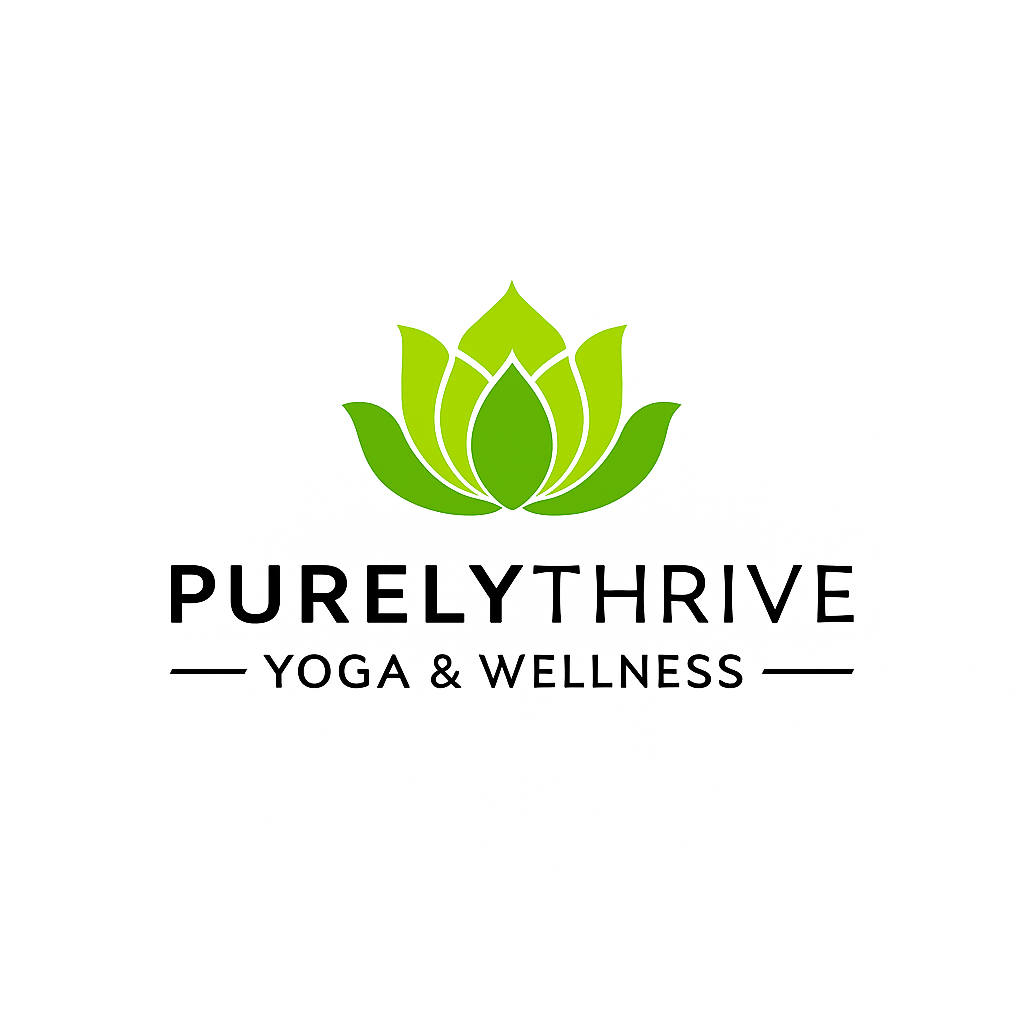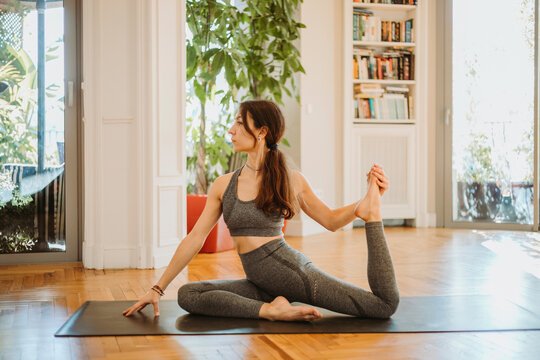Starting a yoga practice can feel overwhelming with hundreds of poses to learn, but beginners only need to master a handful of foundational movements to build a strong practice. These ten essential yoga poses form the building blocks that will help beginners develop proper alignment, build strength, and increase flexibility safely. Each pose teaches important skills like balance, breathing, and body awareness that carry over into more advanced practices.
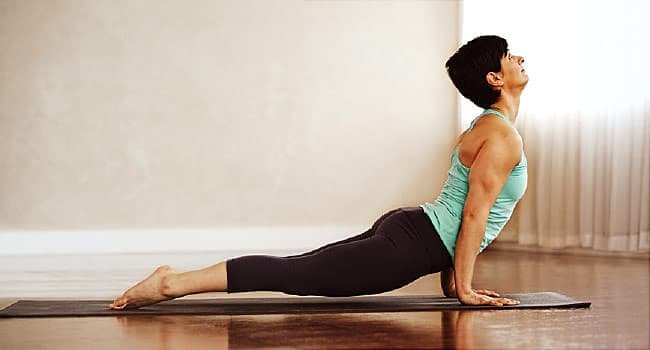
Foundational poses serve as the gateway to understanding how yoga connects the mind and body through movement and breath. From standing poses that build stability to seated stretches that improve flexibility, these basic movements prepare beginners for a lifetime of yoga practice. Learning proper form in these poses prevents injury and creates confidence on the mat.
The poses covered in this guide include balancing postures, gentle backbends, and relaxation techniques that work together to create a complete beginner practice. Each pose includes step-by-step instructions and modifications to help new practitioners find their comfort level while building strength and flexibility gradually.
Why Foundational Yoga Poses Matter
Learning basic yoga poses creates a safe and effective path for new practitioners. These poses build strength, improve flexibility, and teach proper alignment while supporting mental well-being.
The Importance of Building a Strong Foundation
Foundational yoga poses serve as the building blocks for all future practice. These basic postures teach proper alignment and body awareness that prevents injury.
When beginners skip fundamental poses, they often struggle with more advanced movements later. Mountain Pose teaches proper standing posture. Downward-Facing Dog builds shoulder and arm strength.
Each foundational pose targets specific muscle groups. This creates balanced strength throughout the body. New practitioners learn to engage their core muscles correctly.
Proper form matters more than advanced poses. A strong foundation allows students to progress safely. Teachers can spot and correct alignment issues early in practice.
Basic poses also build confidence on the mat. Students feel more secure when they master simple movements first. This confidence carries over to harder poses later.
Benefits for Mind and Body
Yoga poses for beginners offer immediate physical benefits. These poses improve flexibility in tight areas like hips and shoulders. They also strengthen weak muscles from sitting too much.
The practice naturally promotes mindfulness during movement. Students learn to focus on their breath and body position. This mental focus reduces stress and anxiety.
Relaxation happens through gentle stretching and breathing. Simple poses like Child’s Pose calm the nervous system. Students often feel more peaceful after practice.
Regular practice improves sleep quality and energy levels. The combination of movement and breathing helps regulate the body’s systems. Many beginners notice better mood and focus.
Yoga posture work also reduces back pain and improves daily movement. Strong core muscles support the spine better. Better flexibility makes everyday activities easier.
How Foundational Poses Support Progress in Yoga
Basic poses teach movement patterns used in advanced postures. Plank Pose builds arm strength needed for arm balances. Warrior I develops leg strength for standing sequences.
Students learn to coordinate breath with movement through simple poses. This skill becomes essential for flowing sequences later. Proper breathing also prevents fatigue during practice.
Foundational poses reveal individual strengths and limitations. Students discover which areas need more work. This knowledge guides their practice toward specific goals.
These poses also teach safety principles that apply to all yoga. Students learn when to back off from intense stretches. They understand the difference between good stretch and harmful pain.
Progressive practice builds lasting results. Students who master basics advance more quickly than those who rush. Strong foundations prevent common injuries that slow progress.
The 10 Foundational Yoga Poses Explained

These four poses form the core of most yoga practices and provide essential benefits for beginners. Mountain Pose builds proper alignment and posture awareness, while Downward-Facing Dog strengthens the entire body and improves flexibility.
Mountain Pose (Tadasana)

Mountain Pose serves as the foundation for all standing yoga poses. This simple yet powerful pose teaches proper alignment and body awareness.
How to Practice:
- Stand with feet hip-width apart
- Distribute weight evenly on both feet
- Engage leg muscles and lengthen spine
- Relax shoulders away from ears
- Keep arms at sides with palms facing forward
Key Benefits:
- Improves posture and balance
- Strengthens legs and core
- Increases body awareness
- Reduces back pain
Many beginners think Tadasana looks easy, but it requires focus and strength. The pose activates muscles throughout the body while promoting calm breathing.
Common Mistakes:
- Locking knees too tightly
- Shifting weight to one foot
- Tensing shoulders
- Holding breath
Practice Mountain Pose for 30-60 seconds. Use this pose as a starting point for other standing poses and as a reset between more challenging movements.
Downward-Facing Dog (Adho Mukha Svanasana)
Downward-Facing Dog is one of the most recognizable yoga poses. This inverted V-shape position stretches and strengthens the entire body.
Step-by-Step Instructions:
- Start on hands and knees
- Tuck toes under and lift hips up
- Straighten legs as much as possible
- Press hands firmly into mat
- Create straight line from hands to hips
Physical Benefits:
- Stretches hamstrings and calves
- Strengthens arms and shoulders
- Improves circulation
- Relieves tension in spine
Modifications for Beginners:
- Keep knees slightly bent
- Use blocks under hands
- Practice against a wall
- Hold for shorter periods
The pose should feel like an active stretch rather than a collapse. Focus on creating length in the spine while keeping shoulders away from ears.
Breathing Tips: Take deep, steady breaths through the nose. Aim to hold the pose for 5-10 breaths as a beginner, gradually building up to longer holds.
Warrior I (Virabhadrasana I)

Warrior I builds leg strength and improves balance while opening the hips and chest. This powerful standing pose creates stability and confidence.
Setup and Alignment:
- Step left foot back 3-4 feet
- Turn back foot out 45 degrees
- Bend front knee over ankle
- Square hips toward front
- Raise arms overhead
Muscle Engagement: The front leg works to support body weight while the back leg provides stability. Both legs should feel strong and active throughout the pose.
Common Alignment Issues:
- Front knee collapsing inward
- Back hip not squaring forward
- Leaning too far forward
- Shoulders hunching up
Modifications:
- Use a block between thighs
- Place hands on hips instead of overhead
- Take a shorter stance
- Practice against a wall for support
Hold Warrior I for 30-60 seconds on each side. Focus on steady breathing while maintaining the pose’s strong foundation.
Warrior II (Virabhadrasana II)

Warrior II opens the hips and strengthens the legs while improving focus and endurance. This pose builds stamina and mental concentration.
Proper Form:
- Stand with feet 4-5 feet apart
- Turn right foot out 90 degrees
- Keep left foot slightly turned in
- Bend right knee over ankle
- Extend arms parallel to floor
Gaze and Focus: Look over the front hand’s middle finger. This focused gaze helps maintain balance and builds concentration skills.
Key Actions:
- Press down through both feet
- Engage thigh muscles
- Keep torso upright
- Breathe steadily
Beginner Tips:
- Start with shorter holds
- Use a wall behind the back leg for support
- Place forearm on front thigh if arms tire
- Focus on proper knee alignment
The pose should feel grounded and stable. Avoid sinking into the front hip or letting the front knee drift inward.
Building Strength: Start with 30-second holds and gradually increase time. Regular practice of Warrior II builds the foundation for more advanced poses.
Balancing and Seated Foundations
These fundamental poses develop stability, focus, and flexibility through balance challenges and seated positions. Tree Pose builds concentration and leg strength, while Child’s Pose provides gentle stretching and relaxation.
Tree Pose (Vrksasana)
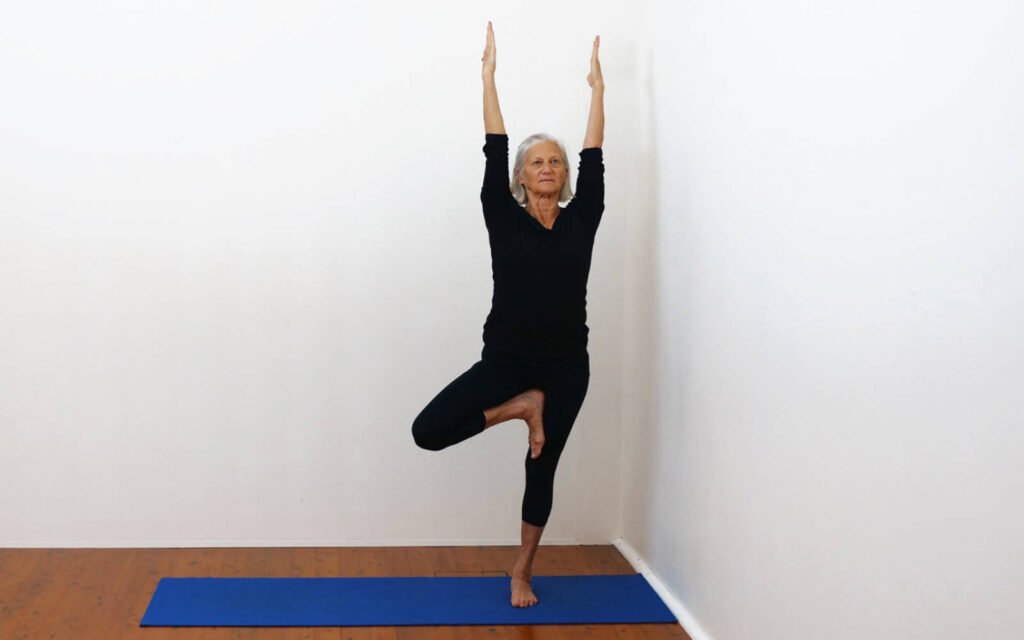
Tree Pose teaches balance and concentration while strengthening the standing leg. The practitioner stands with feet together, then places one foot on the inner thigh or calf of the opposite leg.
Never place the foot on the side of the knee. This can cause joint damage and instability.
The hands can rest at the heart center or extend overhead like branches. The standing leg should be straight and engaged. The core muscles help maintain balance.
Key alignment points:
- Press the lifted foot into the leg
- Keep the standing leg straight
- Square the hips forward
- Find a focus point ahead
Beginners can hold a wall for support or keep the toe of the lifted foot on the ground. The pose improves focus and builds strength in the legs and core muscles.
Child’s Pose (Balasana)
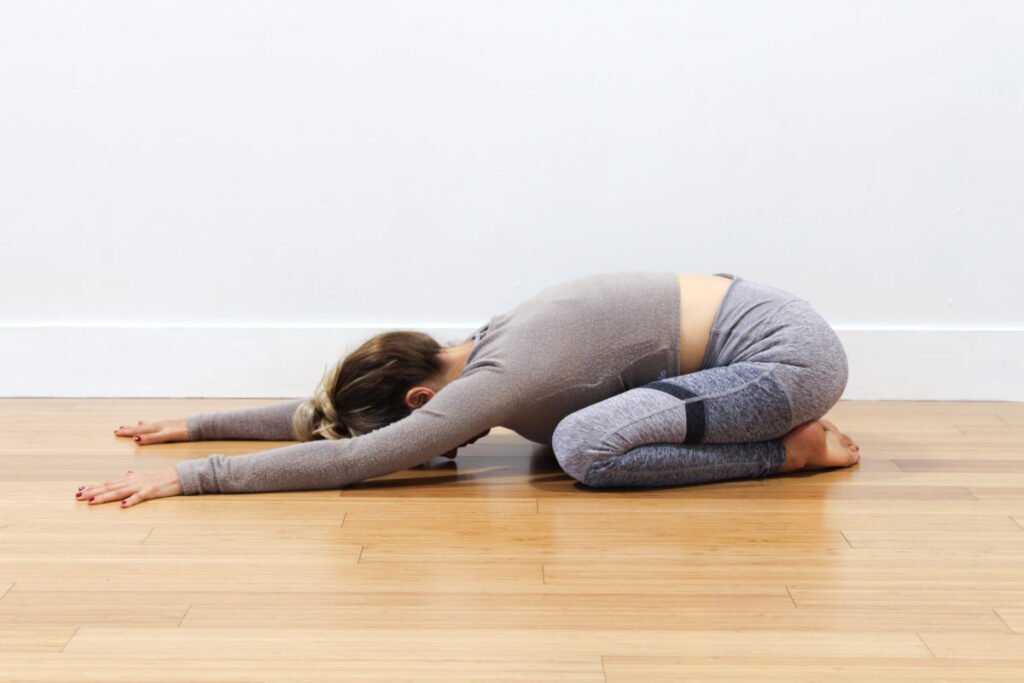
Child’s Pose provides rest and gentle stretching for the back, hips, and shoulders. The practitioner kneels on the floor and sits back onto their heels.
The torso folds forward over the thighs. Arms can extend forward or rest alongside the body. This yoga posture calms the mind and relieves tension.
Modifications for comfort:
- Place a pillow between the calves and thighs
- Widen the knees for more space
- Rest the head on a block
This pose stretches the spine gently. It also opens the hips and shoulders. The position encourages deep breathing and relaxation.
Balasana serves as a resting pose between more challenging postures. It helps reduce stress and anxiety while promoting a sense of safety and calm.
Cobra Pose (Bhujangasana)
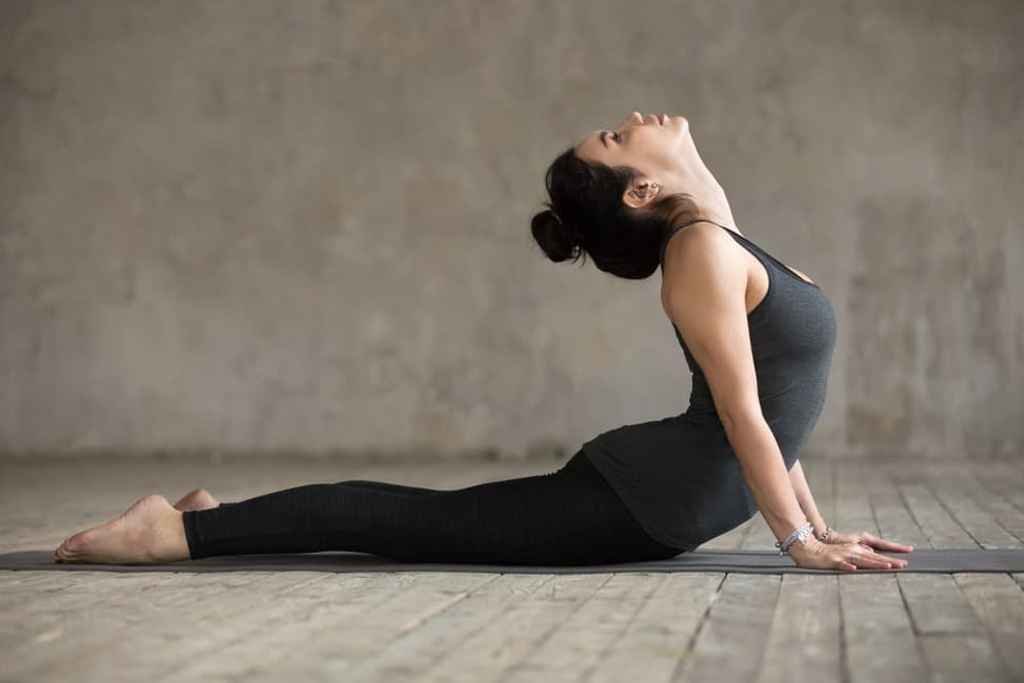
Cobra Pose strengthens the back muscles and opens the chest. The practitioner lies face down with palms under the shoulders. The chest lifts gently while the hips stay on the ground.
Proper form essentials:
- Keep shoulders away from ears
- Engage the back muscles
- Press palms down lightly
- Lift only as high as comfortable
This backbend counteracts slouching and improves posture. It strengthens the spine and stretches the chest and shoulders. The pose also helps with breathing capacity.
Beginners should focus on using back muscles rather than pushing with the hands. The lift should come from the spine, not the arms. Start with small movements and gradually increase the height.
Bhujangasana helps relieve mild back pain and stiffness. It also energizes the body and can improve mood.
Seated Forward Bend (Paschimottanasana)
Seated Forward Bend stretches the entire back of the body. The practitioner sits with legs extended straight ahead. The torso folds forward over the legs, reaching toward the feet.
This pose stretches the spine, shoulders, and hamstrings. It also calms the mind and can aid digestion. The forward fold encourages introspection and relaxation.
Important modifications:
- Bend knees slightly if hamstrings are tight
- Use a strap around the feet for reach
- Sit on a blanket to tilt pelvis forward
The fold should come from the hips, not the back. Keep the spine long rather than rounding it. Breathe deeply and avoid forcing the stretch.
Paschimottanasana helps relieve stress and mild depression. It also stimulates the digestive organs and can help with headaches. The pose requires patience and should never be rushed.
Essential Bridge, Cat, and Cow Poses
These three poses strengthen the back, improve spinal flexibility, and help beginners build core stability. Bridge pose opens the chest while strengthening the glutes, and cat-cow movements create spinal mobility through gentle flexion and extension.
Bridge Pose (Setu Bandhasana)
Bridge pose strengthens the back muscles and opens the chest. It also helps improve posture and can reduce back pain.
How to do Bridge Pose:
- Lie on your back with knees bent
- Place feet flat on the floor, hip-width apart
- Keep arms at your sides, palms down
- Press feet into the floor and lift hips up
- Keep thighs parallel to each other
- Hold for 30 seconds to 1 minute
Key Benefits:
- Strengthens glutes and hamstrings
- Opens chest and shoulders
- Improves spine flexibility
- Reduces stress and fatigue
Beginners should focus on lifting only as high as feels comfortable. The pose should create a straight line from knees to shoulders.
Cat Pose
Cat pose stretches the spine and neck muscles. It helps improve spinal flexibility and releases tension in the back.
How to do Cat Pose:
- Start on hands and knees
- Place wrists under shoulders, knees under hips
- Exhale and arch your back toward the ceiling
- Drop your head and look toward your belly
- Hold for 5-10 seconds
- Return to neutral spine position
Key Benefits:
- Stretches back and neck muscles
- Improves spinal mobility
- Massages internal organs
- Relieves stress and tension
This pose works best when combined with cow pose. The movement should be slow and controlled.
Cow Pose
Cow pose creates the opposite movement of cat pose. It extends the spine and opens the chest.
How to do Cow Pose:
- Begin on hands and knees
- Keep wrists under shoulders, knees under hips
- Inhale and arch your back downward
- Lift your chest and tailbone toward the ceiling
- Look up gently without straining your neck
- Hold for 5-10 seconds
Key Benefits:
- Stretches front of the body
- Improves spinal extension
- Opens chest and throat
- Increases back flexibility
Cat and cow poses flow together smoothly. Most beginners repeat this sequence 5-10 times to warm up the spine.
Practicing Relaxation and Mindfulness
Relaxation and mindfulness form the foundation of yoga practice, helping beginners connect with their breath and calm their minds. Savasana teaches deep relaxation techniques, while mindfulness practices can be woven throughout any yoga session.
Corpse Pose (Savasana)
Savasana appears simple but challenges many beginners. This final pose in most yoga sessions allows the body to absorb the benefits of practice.
The practitioner lies flat on their back with arms at their sides. Palms face up, and legs extend naturally apart. Eyes close gently without squeezing.
Key alignment points:
- Head rests in neutral position
- Shoulders drop away from ears
- Arms lie 6 inches from body
- Legs separate hip-width apart
The breath returns to its natural rhythm. Tension releases from each body part, starting with the toes and moving upward.
Many beginners find their mind wandering during Savasana. This is normal. They can gently return attention to their breath when thoughts arise.
The pose typically lasts 5-10 minutes. Regular practice improves the ability to relax deeply and quickly.
Integrating Mindfulness into Your Yoga Practice
Mindfulness transforms physical poses into a complete mind-body experience. Beginners can start with simple awareness techniques during any pose.
Breath awareness forms the foundation. Practitioners notice the rhythm, depth, and quality of each breath. They avoid forcing changes and simply observe.
Body scanning involves checking in with different body parts. During poses, beginners can notice areas of tension or ease. They observe without judgment.
Present moment focus keeps attention on current sensations. When the mind drifts to daily concerns, practitioners gently return to the pose.
Simple mindfulness cues include:
- Notice the feeling of feet on the ground
- Observe the breath entering and leaving the body
- Feel the stretch in specific muscles
- Notice the quality of thoughts without engaging them
These practices develop concentration and reduce stress. Beginners often find mindfulness more challenging than physical poses, but consistency builds this skill over time.
Tips for Safe and Effective Practice
Starting a yoga practice requires attention to proper preparation and safety measures. New practitioners need to understand how to warm up correctly, recognize their body’s signals, and build a routine that supports long-term success.
Warm-Up and Preparation Techniques
Proper warm-up prepares the body for beginner yoga poses and reduces injury risk. Dynamic movements increase blood flow and joint mobility before static holds.
Start with gentle neck rolls and shoulder circles. Move slowly in both directions for 5-8 repetitions each. This loosens tension from daily activities.
Add gentle spinal movements next. Cat-cow stretches on hands and knees warm the spine effectively. Alternate between arching and rounding the back for 8-10 cycles.
Essential warm-up sequence:
- Joint rotations (ankles, wrists, hips)
- Gentle twists while seated
- Forward fold preparation
- Sun salutation modifications
Hip circles and ankle rotations prepare the lower body. These movements activate smaller stabilizing muscles needed for balance poses.
Take 5-10 minutes for warm-up activities. This time investment prevents strain and improves performance in yoga posture work.
Listening to Your Body and Avoiding Injury
Body awareness prevents injuries and builds confidence in yoga practice. Each person has different flexibility levels and physical limitations.
Warning signs to stop immediately:
- Sharp or shooting pain
- Dizziness or nausea
- Tingling or numbness
- Difficulty breathing
Distinguish between muscle stretch and pain. Stretching feels like gentle pulling, while pain feels sharp or stabbing. Stop any pose that causes discomfort.
Modify poses when needed. Use blocks, straps, or walls for support. There is no shame in using props during beginner yoga poses.
Breathe steadily throughout each yoga posture. Holding breath signals excessive strain. Deep, even breathing indicates proper intensity levels.
Progress happens gradually over weeks and months. Forcing flexibility or strength gains leads to setbacks and injuries.
Creating a Sustainable Practice Routine
Consistency matters more than duration for building a yoga practice. Short, regular sessions create better results than occasional long practices.
Start with 15-20 minutes three times per week. This schedule allows recovery time while building strength and flexibility gradually.
Weekly practice structure:
- Monday: Foundation poses and balance
- Wednesday: Strength-building sequences
- Friday: Flexibility and relaxation
Choose the same time daily when possible. Morning practice energizes the body, while evening sessions promote relaxation and better sleep.
Create a dedicated space for yoga at home. This area should be quiet, clean, and free from distractions. Having a consistent location builds routine habits.
Track progress in a journal or app. Note which poses feel easier and which remain challenging. This awareness helps maintain motivation during difficult periods.
Allow rest days between sessions. Muscles need recovery time to adapt and strengthen. Overtraining leads to fatigue and increased injury risk.
Frequently Asked Questions
New yoga practitioners often have questions about which poses to start with, how often to practice, and how to build a safe routine. These common concerns focus on creating a strong foundation while avoiding injury and maintaining consistency.
What are the essential yoga poses for someone new to the practice?
Mountain Pose serves as the foundation for all standing poses. It teaches proper alignment and balance. Downward-Facing Dog stretches the entire body while building strength.
Child’s Pose provides a resting position between more challenging poses. It helps beginners recover and reset during practice.
Bridge Pose introduces gentle backbending. It strengthens the back and opens the chest safely. Tree Pose develops balance and concentration skills.
Warrior I builds lower body strength. It also improves focus and stability. These six poses create a solid starting point for new practitioners.
What sequence of yoga poses is most recommended for beginners?
Begin with Mountain Pose to establish proper alignment. Move into gentle warm-up movements before advancing to more challenging poses.
Follow standing poses like Warrior I with Triangle Pose. These build strength and stability. Transition to seated poses like Seated Forward Bend.
Include gentle backbends such as Cobra Pose. Add Bridge Pose for additional back strengthening. End with Child’s Pose for rest.
Complete the practice with Corpse Pose for deep relaxation. This sequence allows the body to warm up gradually and cool down safely.
How regularly should a beginner practice the foundational yoga asanas?
Beginners should aim for 3-4 sessions per week. This frequency allows for consistent progress without overwhelming the body. Regular practice builds strength and flexibility gradually.
Each session should last 20-30 minutes initially. Shorter, consistent practices work better than long, infrequent sessions. The body needs time to adapt to new movements.
Daily practice becomes beneficial once basic poses feel comfortable. Even 10-15 minutes daily helps maintain progress. Consistency matters more than duration for beginners.
Can yoga be started at any age, including the senior years?
Yoga welcomes practitioners of all ages and fitness levels. Senior practitioners can safely begin with gentle modifications. Chair yoga provides options for those with mobility concerns.
Age does not prevent someone from starting yoga. The practice adapts to individual needs and abilities. Props like blocks and straps assist with accessibility.
Older beginners should start slowly and listen to their bodies. Consulting with healthcare providers ensures safety. Many find yoga improves balance and reduces stiffness.
What are the names and correct forms of the basic yoga poses for newcomers?
Mountain Pose (Tadasana) requires standing tall with feet together. Arms rest alongside the body with palms facing forward. The pose emphasizes proper posture and alignment.
Downward-Facing Dog (Adho Mukha Svanasana) forms an inverted V-shape. Hands press firmly into the mat while hips lift toward the ceiling. Legs gradually straighten as flexibility improves.
Child’s Pose (Balasana) involves kneeling with big toes touching. The torso folds forward between the thighs. Arms can extend forward or rest alongside the body.
Tree Pose (Vrksasana) balances on one foot. The other foot presses against the inner thigh or calf. Hands join in prayer position at the chest.
How do beginners integrate yoga poses into a daily wellness routine?
Morning practice energizes the body for the day ahead. Simple poses like Mountain Pose and gentle stretches work well. A 10-minute routine fits easily into busy schedules.
Evening yoga helps release daily tension. Restorative poses like Child’s Pose and Corpse Pose promote relaxation. This timing supports better sleep quality.
Short pose sequences can break up long periods of sitting. Office workers benefit from desk-friendly stretches. Even three poses practiced consistently make a difference.
Link yoga practice to existing habits for better consistency. Practice after brushing teeth or before meals. This connection helps establish a lasting routine.
